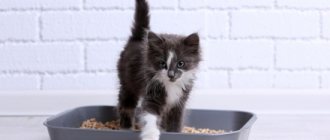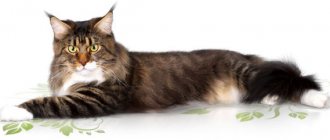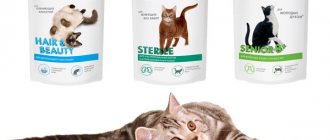The pet supply market is overflowing with all kinds of accessories for pets that make it easier to live with them. But you should pay special attention to choosing a tray for your cat. If cat litter is not to your pet's liking, it will spell disaster. The animal may flatly refuse to use the new inconvenient device and take a liking to the secluded corners of your home.
You can make a closed toilet with your own hands the old fashioned way and remove the litter after each bowel movement. Or you can buy a modern model - a closed cat litter box, this is the best option for those who are not ready or cannot clean it every hour.
What types of cat litter are there?
Even before the pet arrives at its new home, you need to buy everything it will need - a house, a scratching post, bowls for water and food, a carrier and, of course, a toilet. This part of the cat household must meet many requirements and fit organically into the interior of the apartment or house. The choice of cat litter on the modern market is huge.
First of all, they can be divided into two types:
- open type;
- closed.
Open cat litter boxes can also be different.
The simplest one is a rectangular plastic tray made of durable plastic. However, it can be of any shape - round, oval, triangular, of various widths, lengths and heights. For example, a Trixie toilet made in Germany with dimensions of 37x27x9 cm costs 348 rubles. This model is suitable for kids who are just learning this device.
The design with a high removable side is a little more complicated. It is heavier and more stable. Suitable for older kittens or a small adult cat. For example, the pink Homecat model, with dimensions 52x38x17, costs 894 rubles.
Some types of filler require models with a mesh on the bottom. A good example of such a solution is the Italian Furba model produced by Stefanplast, its dimensions are 39x59x22, the cost is 1309 rubles.
The types of closed trays are more varied, although they all have predominantly a house shape.
Customer Reviews
Arkady, 25 years old:
“I bought a small closed tray for my little kitten. It was very inconvenient for him to enter because of the tightly closing door. I had to wipe after him several times because the pet began to shit in the wrong places. I ordered a new model without a door for my baby. There's just a window for entry. Quite a convenient and practical solution for cat litter. Easy to clean and has ventilation windows.”
Ulyana, 45 years old:
“I have 2 cats. Previously, I kept 2 large toilet houses for them. After moving to a new apartment, there was no free space for them. We had to take one large toilet for two. At first I thought that they would fight if they entered the closed tray together, but then I calmed down. Cats do well in a spacious house. Sand doesn’t fall out of it and there’s no unpleasant smell.”
Advantages and disadvantages of an enclosed toilet
When choosing a closed litter box for a cat, you need to focus on many parameters, but first of all, you should understand what their pros and cons are.
The advantages of closed cat litter boxes include:
- Privacy. The ability of the pet to isolate itself and go to the toilet alone, and not in front of everyone.
- Cleanliness in the house. The cat always digs into the tray with pleasure, sometimes scattering the litter in all directions. In the case of a closed toilet, the top box prevents debris from flying around.
- Reducing odors. Sometimes a cat’s trip to the toilet is accompanied by unpleasant “odors.” A closed tray reduces their level, and sometimes completely eliminates them, especially if the model has a carbon filter.
- Aesthetics. This toilet looks like a nice closed house and fits well into the interior of the apartment. You can choose a model according to the color preferences of your household.
- Possibility of choice. Closed litter boxes come in so many different forms that you can easily choose the size that suits your pet.
There are few disadvantages to such toilets:
- Some cats categorically refuse to wear them. It's hard to say what this is connected with. Perhaps the childhood habit of having a small open tray was the strongest. Often pets do not like the door, but usually it is easily removed and the problem is quickly resolved.
- The high cost compared to open trays makes purchasing such a toilet inconvenient for some owners.
- Due to its large size, it is not always possible to install a closed toilet in small apartments without problems. And it’s certainly not a small tray that can be pushed under the bathtub.
The main differences between a closed tray
Manufacturers of pet products offer a variety of models of closed cat litter boxes, ranging from a conventional “house” with a retractable sand tray to a modern automated bio-toilet. In any case, such structures look like boxes, snail houses, high cabinets, carriers with an open or self-closing entrance.
Some trays are triangular in shape and fit well in corners. Inside there is space for sand or filler. The main thing is that the top part is easy to remove and the smell of feces is not absorbed.
Attention! It is not recommended for small pets to purchase a closed tray. It will be difficult for kittens to step over high sides or open the door.
Types of closed toilets
There are many types of closed toilets, although the basic essence of the design remains the same. This is a lower tray, which can be stationary or retractable, and an upper box with or without a door that covers the base.
Below are the main types of closed cat litter boxes.
SAVIC Nestor Jumbo
This company produces closed bio-toilets for cats with a removable lid and door. The design has dimensions of 66.5x48.5x46.5 cm, its cost is 2,550 rubles.
This is the simplest type of indoor cat litter box. The upper part is equipped with a handle, with which you can easily move it from place to place. It is attached to the lower pallet with special latches that ensure structural rigidity. By removing the top, the toilet can easily be converted into a regular tray with high sides.
The lid has a special slot for removable activated carbon filters, which absorb odors and purify the air. It also has a door, which you can open to change the filler. She reclines in any direction. But it’s more convenient to clean the tray by simply removing the top part.
The door can be easily removed or locked open, making toilet training for timid cats easier.
Toilet cabinet
A closed high tray for cats with a top entrance in the form of a cabinet (made in Japan) has dimensions of 41x52x37 cm. Cost 3,800 rubles.
It resembles an oval cylinder, closed on top with a removable lid with a ribbed surface (to wipe paws) and a hole. In order to go to the toilet, the cat needs to jump inside. The high walls of the device do not allow filler particles to fly away in different directions.
This model is not suitable for small kittens - they simply will not be able to jump into such a toilet.
Curver "Pet Life"
The Curver “Pet Life” bio-toilet for cats is a closed design with a retractable tray. Dimensions 51x39x40 cm, price - 4,253 rubles.
The peculiarity of this design is a retractable bottom tray and a small mesh at the entrance to the toilet itself. It is designed to ensure that small particles of filler stuck to the animal’s paws fall off when the cat walks over it. The top cover is also removable and has a door. The plastic is dense and durable, stylized as wicker straw. The design is equipped with cleaning filters and sometimes with a special absorbent mat.
IMAC "Ginger"
Bio-toilet for cats IMAC “Ginger” - closed type, corner. This model has dimensions 50x50x44.5 cm, cost - 2,429 rubles.
It is made of high quality plastic and also comes with a removable lid with latches, a carbon filter, a carrying handle and a scoop. The top part is easily removable and has special latches. Thanks to its design, it is convenient to place it in the corner of any room.
Tunnel toilet
The two-chamber Japanese tunnel bio-toilet for cats differs from other models in its large size and has two internal chambers. The first has a special grid for cleaning paws, the second serves directly as a litter tray. The lid is removable with a transparent door, the kit includes filters for replacement and a mesh scoop for removing excrement.
All parts are made of special plastic with silver ion sputtering, which provides bactericidal air purification.
The cost of such a toilet is about 7,000 rubles.
Cat Genie toilet
The automatic bio-toilet for cats Cat Genie has dimensions of 53.3x61x40.7 cm, bowl diameter - 48.3 cm. Cost 34,900 rubles.
This device requires connection to cold water supply, sewerage and electricity. Includes, in addition to a bowl with a special filler, cartridges with detergent, hoses and wires.
After going to the toilet, the cat can calmly rummage around in it, since the filler granules are no different in appearance from ordinary ones. But as soon as the pet gets out of the tray, the cleaning system turns on.
A special shovel digs out solid waste, the filler is washed, and liquid waste flows into the tank. Then all the soaked waste with detergent residues flows down the drain and the hot air supply is turned on. The washed filler granules are dried and ready for use again.
There is a sensory system responsible for the safety of the animal.
Litter-Robot
The fully automatic, robotic cat litter box measures 74.93 x 68.58 x 61.6 cm, with external parts made of plastic. Features an electrical adapter, filter system, oval inlet, removable tray and space design. Price 69,000 rubles.
In order for the device to work, it is enough to pour in any clumping filler (preferably silica gel) and plug it into the electrical network. After the cat has gone to the toilet, the system begins cleaning - the drum rotates, particles of filler cover the feces, then they fall into the storage tank. Clean, evenly distributed filler remains in the tray.
If the pet becomes interested in the operation of the device and goes to the toilet again, the system will stop; special touch sensors are responsible for this.
Recommendations for use
Manufacturers remind you that hygienic cleaning in toilets with a lid is carried out with the same frequency as in open ones. The exception is options that have their own purification systems and are connected to the sewer and water supply networks. All details regarding the frequency of cleaning are described in detail in the instructions supplied with the product.
For your information! Automatic flushing for certain types is activated after 20 seconds. after the pet leaves, there can be no erroneous processing, since the presence of the animal is detected by built-in touch sensors.
Designs with a self-cleaning function are easy to use and always clean (from a hygienic point of view). Bags in automatic products are replaced weekly; for some, there is no need for the usual filler. These come with special compounds through which the animal’s urine goes into the drain, and solid waste is removed with a rotating scoop.
The convenience of automation lies in the ability to independently set the appropriate time for cleaning procedures. After the removal of foreign impurities is completed, the filler is thoroughly washed and then dried. When purchasing a product, it must be installed by a plumber to connect it to sewer and water pipes.
Self-cleaning models have different operating principles. Some have a special device responsible for collecting and sending excrement to the lower tank (the working surface remains clean). These models require the purchase of disposable or reusable sanitary bags. Their disadvantages include the presence of an odor before the package is sent to the garbage disposal.
Important! Manufacturers note that attempts to flush the filler down the toilet can end in disaster. The granules that have increased due to the liquid will clog the sewer and create an emergency situation. The problem will have to be solved by calling a plumber.
One-piece house products occupy a worthy niche in the cat products market. Ease of use and the possibility of using a fully automated system make owners think about purchasing an expensive but convenient design. If desired, you can choose a more economical and inexpensive option without automation with a manual type of cleaning.
Mr. Cat recommends: how to choose, what to consider
When choosing a toilet for your pet, you need to consider the following factors:
- Pet's age. It is difficult for a very small kitten to jump into a dry closet with a high tray. First, you should accustom him to a small open tray. And then purchase a closed model with a low retractable tray.
- Dimensions of the animal. When purchasing an indoor toilet, you should remember what size your pet will be when it finally grows up. For small breeds, devices of standard sizes are suitable, but for those such as Savanah, Chausie, Maine Coon, it is better to immediately purchase large devices.
- Area in an apartment or house. When choosing a toilet, you need to imagine what space it will take in the room. If the size of the room is not sufficient, then you can choose a corner model.
- Choice of design. It is better not to purchase a litter box that may remind your pet of being in a carrier. For some animals, any moving causes unpleasant associations, for example, reminding them of visits to the veterinarian.
- Convenience of the device. It is important to make sure that the top cover and door can be easily removed so that cleaning the tray can be done without obstruction.
- No odors. They should not be inside a closed space. You should pay attention to the quality of the plastic and the presence of ventilation holes and filters.
What is a tray house
A toilet-house for cats creates a feeling of security and can be placed in any corner of the apartment. The tray easily retains odors inside, has an aesthetic appearance and eliminates the need for a constantly open door for the animal to access the potty.
The toilet house is a very convenient accessory
When purchasing a new container, you need to pay attention to its ease of maintenance. The outer part should be easily separated from the bottom, which will allow cleaning at any convenient time.
Important! Most houses have a special door that “closes” unpleasant odors inside. Not all pets get along well with it; some try to use the potty as a bed. During the adaptation period and getting used to the potty, it can be removed.
Protection against unpleasant odors
Veterinarians' opinion
When choosing a litter box for a cat, veterinarians advise giving preference to closed-type bio-toilets. In this case, it is easier to comply with hygienic requirements for caring for the animal. In addition, when using such models, less dirt from the animal’s paws is spread throughout the living space.
Experts do not advise purchasing cheap Chinese products made from low-quality fragile plastic. Pets often get injured and cut their paw pads when these products break. But animals, having become overplayed, often jump onto the “roof” of toilet houses.
There should be no sharp, cutting edges or elements inside the pallet.
How to train a cat to use a litter box
In order to quickly accustom your pet to a new toilet, especially if he has previously used an open litter box, you can use a number of techniques:
- Remove the door for the first time. Many animals are afraid of it and even lock themselves inside, although it opens in different directions.
- At first, you can even remove the top cover and leave only the tray. When the cat gets used to the new tray, you can put the top part back in place.
- Before use, it is better to wipe the plastic with a weak bleach solution. All cats are attracted to this smell, but in small concentrations.
- You can put some used cat-scented litter from an old litter box into the new litter box. This way the pet will quickly realize that this is a new place to relieve its natural needs.
- At first, you can simply place the old litter box next to the new toilet-house. Gradually, the pet will get used to the new device and its smell.
- You can limit the cat's movement around the house for a day or two. Nothing bad will happen if at this time she is only in the room where the new device is located.
- It’s easy to make a closed toilet yourself at first - just cover the old tray with a cardboard box with a cut-out window. Pets usually love to climb into them.
- If the process is delayed and the cat stubbornly goes to the toilet in the wrong place, you can use special sprays - Gadin and Antigadin, which have attractive and repulsive odors.
1111











